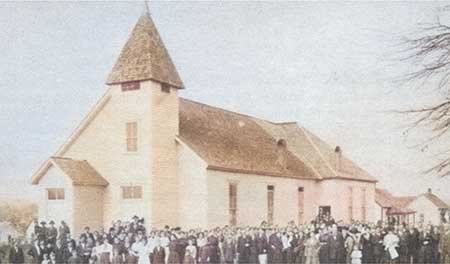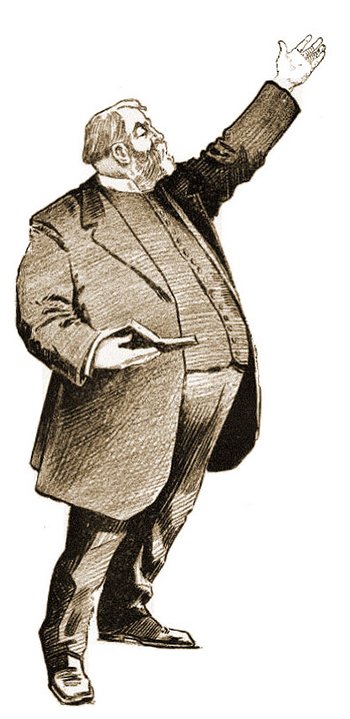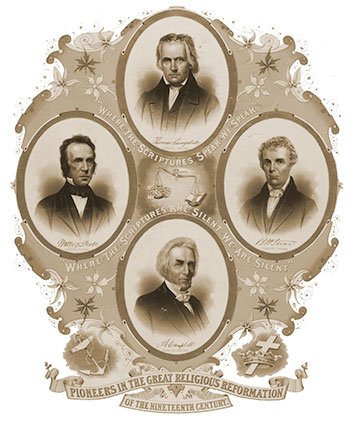1896 Shearer Schoolhouse Revival

Shearer Schoolhouse Revival
Characterized by fervent prayer, passionate preaching, and what participants believed to be the biblical experience of speaking in tongues, the revival ignited a spiritual fire that spread throughout the region and beyond, leaving a lasting impact on the religious landscape of the nation1. Some believe that this was the first mass outpouring of the Holy Ghost (with speaking in tongues) since the time of the Early Church1.
But this ignores the historical and verified evidence of the spiritual awakening that occurred under the leadership of Edward Irving in UK in 1830 and the Holy Ghost ministry of Maria Woodworth Etter which began in 1885. Nevertheless, this remarkable event warrants revival students taking a closer look at this amazing outpouring of God’s Spirit.
Here we will be exploring its antecedents, key figures, and the specific practices that contributed to its success. It also examines the revival’s immediate and long-term consequences, including its influence on the development of Pentecostal denominations and its relationship to other revival movements in the United States.
Timeline of Events
| Date | Event | Significance | Sources |
| 1880s | Latter Rain Holiness movement emerges | Sets the stage for spiritual renewal and a focus on New Testament principles. | 2 |
| 1886 | Christian Union established | Creates a new church that unites Christians from various denominations. | 1 |
| 1892 | William F. Bryant begins prayer meetings | Fosters a spirit of prayer and anticipation for revival in Camp Creek. | 3 |
| Summer 1896 | Shearer Schoolhouse Revival begins | Ten-day revival meeting led by four lay evangelists. | 1 |
| 1896 | Speaking in tongues manifests | Participants experience glossolalia as evidence of the baptism of the Holy Spirit. | 1 |
| 1899 | Local churches excommunicate revival participants | Highlights the controversy and opposition surrounding the revival. | 1 |
| 1902 | Christian Union reorganizes as the Holiness Church at Camp Creek | Reflects the growing emphasis on holiness and sanctification. | 1 |
| Early 20th century | Pentecostal movement expands | The Shearer Schoolhouse Revival contributes to the growth of Pentecostalism in the United States. | 4 |
The Religious Landscape of America in 1896
The late 19th century in the United States, often referred to as the Gilded Age, was a period of significant transformation and upheaval5. Rapid industrialization, urbanization, and immigration brought about profound social and economic changes, creating both unprecedented prosperity and stark inequalities. This period of dynamism and disruption also had a significant impact on the religious landscape of the nation.
The established religious denominations, such as Baptists, Methodists, and Presbyterians, faced challenges in adapting to the changing social order6. Theological controversies and internal divisions arose as these denominations grappled with issues such as modernism, social reform, and the role of religion in an increasingly secularized society.
Simultaneously, new religious movements emerged, offering alternative spiritualities and attracting those seeking meaning and purpose in a rapidly changing world7. Christian Science, with its emphasis on healing and spiritual well-being, and Theosophy, with its blend of Eastern and Western mystical traditions, gained followers among those disillusioned with traditional Christianity or seeking new forms of religious expression.
The Mormon community, having established a home in Utah after years of persecution, continued to face scrutiny and opposition due to their unique beliefs and practices8. Their strong communal structure and emphasis on social cohesion, while providing stability and support for members, also generated suspicion and hostility from those outside the Mormon faith.
Amidst this religious ferment, a renewed emphasis on personal experience and emotional expression in religion emerged9. The Holiness movement, which emphasized the possibility of achieving entire sanctification and living a life free from sin, gained momentum in the late 19th century.
This movement, with its focus on conversion, divine freedom and a deeper relationship with God, laid the groundwork for the Pentecostal movement, which would further emphasize the experience of speaking in tongues as evidence of the baptism of the Holy Spirit.
The Shearer Schoolhouse Revival emerged from this complex and dynamic religious landscape, reflecting both the challenges and the opportunities present in American Christianity at the turn of the 20th century.
Antecedents of the Revival
The Shearer Schoolhouse Revival did not occur in a vacuum. It was rooted in a series of events and influences that prepared the ground for this spiritual outpouring. One significant antecedent was the Latter Rain Holiness movement, which emerged in North Carolina and Tennessee in the 1880s2. This movement, led by Baptist preacher Richard Spurling Sr., emphasized the need for spiritual renewal and a return to the principles of the New Testament1.
In 1886, Spurling Sr., then 72 years old, and his son, Richard Spurling Jr., both licensed Baptist preachers, established the Christian Union, a new church that sought to unite Christians from various denominations under the banner of the New Testament1. This church, which would later evolve into the Church of God (Cleveland), played a crucial role in the events leading up to the Shearer Schoolhouse Revival1.
Another important figure in this story is William F. Bryant, a Baptist lay preacher who began holding prayer meetings in his home in Camp Creek in 18923. Bryant connected with Spurling Jr. and the Christian Union, and their shared emphasis on prayer and spiritual unity fostered a sense of anticipation for revival in the community3.
The merging of Spurling’s and Bryant’s congregations was a significant step towards breaking down denominational barriers and fostering a spirit of unity among believers3. This act of unity foreshadowed the spirit of cooperation and mutual support that would characterize the Shearer Schoolhouse Revival.
The Revival Begins
In the summer of 1896, the Christian Union organized a ten-day revival meeting at the Shearer Schoolhouse in Camp Creek1. Four lay evangelists—William Martin, Billy Hamby, Joe Tipton, and Milton McNabb—led the meetings, preaching the message of holiness and sanctification10. The evangelists were “given to much prayer and fasting,” and their passionate preaching resonated with the community10.
From the outset, the revival was marked by a powerful sense of God’s presence. People flocked to the Shearer Schoolhouse from surrounding areas, drawn by reports of conversions and spiritual experiences10. The altars were filled with “repentant sinners and seekers for the experience of sanctification.” 10 Many sceptics of holiness were convinced, and numerous “rough-living sinners” were converted10.
Prayers and Practices
The success of the Shearer Schoolhouse Revival can be attributed, in part, to the specific prayers and practices that characterized the meetings. The evangelists and participants engaged in fervent prayer, seeking God’s guidance and power3. They believed that prayer was essential for preparing the ground for revival and for experiencing the fullness of God’s blessings11.
This belief was rooted in the historical precedent of prayer preceding revivals, like in the ministry of Jonathan Edwards or as seen in later movements like the Welsh Revival 11.
One notable practice was the emphasis on unity and breaking down denominational barriers. The Christian Union, which brought together people from various church backgrounds, fostered a spirit of cooperation and mutual support3. This unity created an environment where people felt comfortable seeking God together, regardless of their denominational affiliations.
Another important practice was the focus on sanctification, the belief that Christians can experience a deeper level of holiness and live a life free from sin12. The evangelists preached the message of sanctification with conviction, and many participants testified to experiencing this transforming work of God in their lives10.
Speaking in Tongues
One of the most distinctive features of the Shearer Schoolhouse Revival was the manifestation of speaking in tongues, also known as glossolalia1. Participants believed that this phenomenon, described in the New Testament book of Acts, was a sign of the baptism of the Holy Spirit1.
As the revival progressed, more and more people reported speaking in tongues13. This experience, often accompanied by intense emotions and a sense of God’s presence, further fuelled the revival fire1. The Shearer Schoolhouse Revival is considered one of the earliest instances of mass glossolalia in the United States, predating the Azusa Street Revival in Los Angeles by a decade1.
While the 1906 Azusa Street Revival is often seen as the birth of modern Pentecostalism, the Shearer Schoolhouse Revival and other similar occurrences demonstrate that the Pentecostal movement had roots in various parts of the country and emerged from a confluence of influences1.
The manifestation of speaking in tongues at Shearer Schoolhouse also highlights the historical continuity of this phenomenon, which has resurfaced during various periods of religious revival throughout history14.
Controversy and Persecution
The revival’s emphasis on sanctification and speaking in tongues sparked controversy and opposition from some segments of the community15. Local Baptist and Methodist churches, wary of the new doctrines and practices, excommunicated members who participated in the revival in 18991.
The opposition escalated to persecution, with some opponents resorting to violence and intimidation16. Homes where revival meetings were held were burned, water sources were contaminated, and children of revival participants were mistreated at school3. Homes were shot at and vandalized, and believers faced threats and intimidation16. The meeting house itself was targeted, with opponents first attempting to destroy it with fire and dynamite.
When these attempts failed, a mob of over 100 community leaders, including ministers, deacons, a justice of the peace, and a sheriff, dismantled the log meetinghouse and burned the logs3. Despite these challenges, the revival continued to grow, with believers meeting in homes and brush arbors to avoid persecution16.
Immediate and Lasting Results
Despite the opposition and persecution they encountered, the participants of the Shearer Schoolhouse Revival persevered, and the revival had a significant impact on the community and beyond. Over 100 people were baptized with the Holy Spirit and spoke in tongues3. The revival led to the formation of new churches and the strengthening of the Christian Union16.
One significant outcome of the revival was the development of a form of government and the establishment of doctrines to unite the believers and protect them from false teachings3. This organizational development laid the foundation for the future growth and stability of the movement.
The revival’s influence extended beyond the immediate region. It contributed to the growth of the Holiness movement and laid the groundwork for the Pentecostal movement, which would experience explosive growth in the early 20th century4. The Shearer Schoolhouse Revival is recognized as a pivotal event in the history of Pentecostalism, demonstrating the growing emphasis on spiritual experience and the manifestation of spiritual gifts in American Christianity14.
Personal Testimonies
While detailed accounts of specific individuals’ experiences during the Shearer Schoolhouse Revival are limited, some testimonies provide glimpses into the personal impact of this spiritual outpouring. W.F. “Will” Bryant, a Baptist church member who initially did not believe in sanctification, shared his experience of seeking a deeper relationship with God during the revival10. He observed how those who claimed sanctification would confess their sins to one another and seek reconciliation, which inspired him to pursue a similar experience. Eventually, while sitting on his horse, Bryant experienced a profound sense of sanctification10. This personal account highlights the transforming power of the revival and its impact on individuals’ spiritual journeys.
Beneficial Takeaways
The Shearer Schoolhouse Revival offers several valuable lessons for Christians today. It highlights the importance of:
- Fervent prayer: The revival demonstrates the power of prayer in preparing for and sustaining spiritual awakening.
- Unity among believers: The Christian Union’s emphasis on unity created an environment where people from different backgrounds could come together to seek God.
- Sanctification: The revival emphasized the possibility of experiencing a deeper level of holiness and living a life free from sin.
- Spiritual gifts: The manifestation of speaking in tongues underscored the reality of spiritual gifts and their role in Christian experience.
- Perseverance in the face of opposition: Despite persecution, the revival participants remained steadfast in their faith and continued to meet and worship together.
The Shearer Schoolhouse Revival serves as a reminder that God can move powerfully in unexpected places and through ordinary people. It is a testament to the enduring power of the Gospel and the transforming potential of seeking the presence of the Holy Spirit.
Conclusion
The Shearer Schoolhouse Revival of 1896 was a pivotal event in the history of Pentecostalism in the United States. It emerged from a context of religious and social change in the late 19th century, fuelled by a desire for spiritual renewal and a return to biblical principles. The revival’s emphasis on fervent prayer, unity among believers, sanctification, and the manifestation of spiritual gifts contributed to its success and lasting impact. Despite facing controversy and persecution, the revival participants remained steadfast in their faith, leaving a legacy that continues to inspire and challenge Christians today.
The revival’s significance extends beyond its immediate impact on the Camp Creek community. It played a crucial role in the development of the Pentecostal movement, which would become a major force in American Christianity and spread throughout the world in the 20th-21st century. The emphasis on spiritual experience, including speaking in tongues, that characterized the Shearer Schoolhouse Revival foreshadowed the key tenets of Pentecostal theology and practice.
The Shearer Schoolhouse Revival witnesses to the transforming power of the Holy Spirit and the enduring hope of spiritual awakening. It reminds us that God can work through ordinary people in unexpected places to bring about extraordinary results. The revival’s legacy continues to resonate today, inspiring Christians to seek a deeper relationship with God, pursue holiness, and embrace the fullness of spiritual gifts.
Works cited
- Shearer Schoolhouse Revival – Wikipedia, accessed on December 17, 2024, https://en.wikipedia.org/wiki/Shearer_Schoolhouse_Revival
- Latter Rain (1880s movement) – Wikipedia, accessed on December 17, 2024, https://en.wikipedia.org/wiki/Latter_Rain_(1880s_movement)
- 1896 Shearer Schoolhouse Revival – BEAUTIFUL FEETBEAUTIFUL …, accessed on December 17, 2024, https://romans1015.com/1896-shearer-schoolhouse-revival/
- Beliefs – Eastern North Carolina Church of God, accessed on December 17, 2024, https://enccog.org/beliefs
- American religion in the Gilded Age | News | Cushwa Center – University of Notre Dame, accessed on December 17, 2024, https://cushwa.nd.edu/news/the-republic-for-which-it-stands/
- History of religion in the United States – Wikipedia, accessed on December 17, 2024, https://en.wikipedia.org/wiki/History_of_religion_in_the_United_States
- Religion in America | United States History I – Lumen Learning, accessed on December 17, 2024, https://courses.lumenlearning.com/wm-ushistory1/chapter/religion-in-america/
- The Path to Utah Statehood | American Experience | Official Site – PBS, accessed on December 17, 2024, https://www.pbs.org/wgbh/americanexperience/features/mormons-utah/
- Timelines | US Religion, accessed on December 17, 2024, https://www.thearda.com/us-religion/history/timelines?tid=10&tab=1
- The Shearer Schoolhouse Revival – Faith News Network, accessed on December 17, 2024, https://www.faithnews.cc/?p=9661
- A call to Prayer – COGOP Prayer Ministries, accessed on December 17, 2024, http://cogopprays.org/calltoprayer/
- A BRIEF HISTORY OF THE CHURCH OF GOD, accessed on December 17, 2024, https://churchofgod.org/about/a-brief-history-of-the-church-of-god/
- A Charismatic Looks at the Birth of Pentecostalism – The Pneuma Review, accessed on December 17, 2024, http://pneumareview.com/a-charismatic-looks-at-the-birth-of-pentecostalism/
- Azusa Street Revival Archives – Page 3 of 5 – BEAUTIFUL FEETBEAUTIFUL FEET, accessed on December 17, 2024, https://romans1015.com/tag/azusa-street-revival/page/3/
- Early History | Fields of the Wood – Church of God of Prophecy, accessed on December 17, 2024, https://cogop.org/fow/earlyhistory/
- ‘No Cause to Hide’ – Evangel Magazine, accessed on December 17, 2024, https://www.evangelmagazine.com/2017/11/no-cause-hide/
- About Us – Church of God of Prophecy, accessed on December 17, 2024, https://cogop.org/aboutcogop/
- Nearby Sites | Fields of the Wood – Church of God of Prophecy, accessed on December 17, 2024, https://cogop.org/fow/nearbysites/



